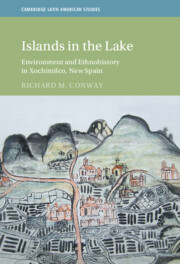Book contents
- Islands in the Lake
- Cambridge Latin American Studies
- Islands in the Lake
- Copyright page
- Dedication
- Contents
- Illustrations
- Preface
- Acknowledgments
- Introduction
- 1 Ecological and Political Landscapes
- 2 Land
- 3 Canoes and Commerce
- 4 Demography and Society
- 5 Crisis in the Seventeenth Century
- 6 Late Colonial Watersheds
- 7 Nahuatl Sources from Xochimilco
- Conclusion
- Glossary
- Bibliography
- Index
- Other Books in the Series (continued from page ii)
Conclusion
Published online by Cambridge University Press: 01 October 2021
- Islands in the Lake
- Cambridge Latin American Studies
- Islands in the Lake
- Copyright page
- Dedication
- Contents
- Illustrations
- Preface
- Acknowledgments
- Introduction
- 1 Ecological and Political Landscapes
- 2 Land
- 3 Canoes and Commerce
- 4 Demography and Society
- 5 Crisis in the Seventeenth Century
- 6 Late Colonial Watersheds
- 7 Nahuatl Sources from Xochimilco
- Conclusion
- Glossary
- Bibliography
- Index
- Other Books in the Series (continued from page ii)
Summary
As the native-language sources suggest, the history of Xochimilco and the chinampa districts still exhibited a great deal of continuity at the end of the colonial period. The area’s residents were predominantly Nahuas and they retained their demographic superiority by a wide margin over non-Native peoples. The Nahuas still spoke Nahuatl, of course, and they continued to bequeath chinampas, grain bins, and other indigenous items to their heirs in documents set down in their own language. The Nahuas resided in tlaxillacalli, those subunits of the altepetl which, itself, remained intact (as did the civil and ecclesiastical jurisdictions that relied on it). The Nahuas’ communities were still located in the same, broadly recognizable landscape, one that stretched from the lakes to the sierras. Unlike Lakes Zumpango and Xaltocan to the north of the Basin of Mexico – which had essentially dried up – Lakes Xochimilco and Chalco were still deeply lacustrine environments (devastatingly so, at the frequent times of flooding). Much of the water management program persisted, including the dams and embankments and the hydraulic compartments as well as the ancient causeways of Mexicalzingo and Tlahuac, the latter having been renovated in the late eighteenth century.
- Type
- Chapter
- Information
- Islands in the LakeEnvironment and Ethnohistory in Xochimilco, New Spain, pp. 344 - 352Publisher: Cambridge University PressPrint publication year: 2021



